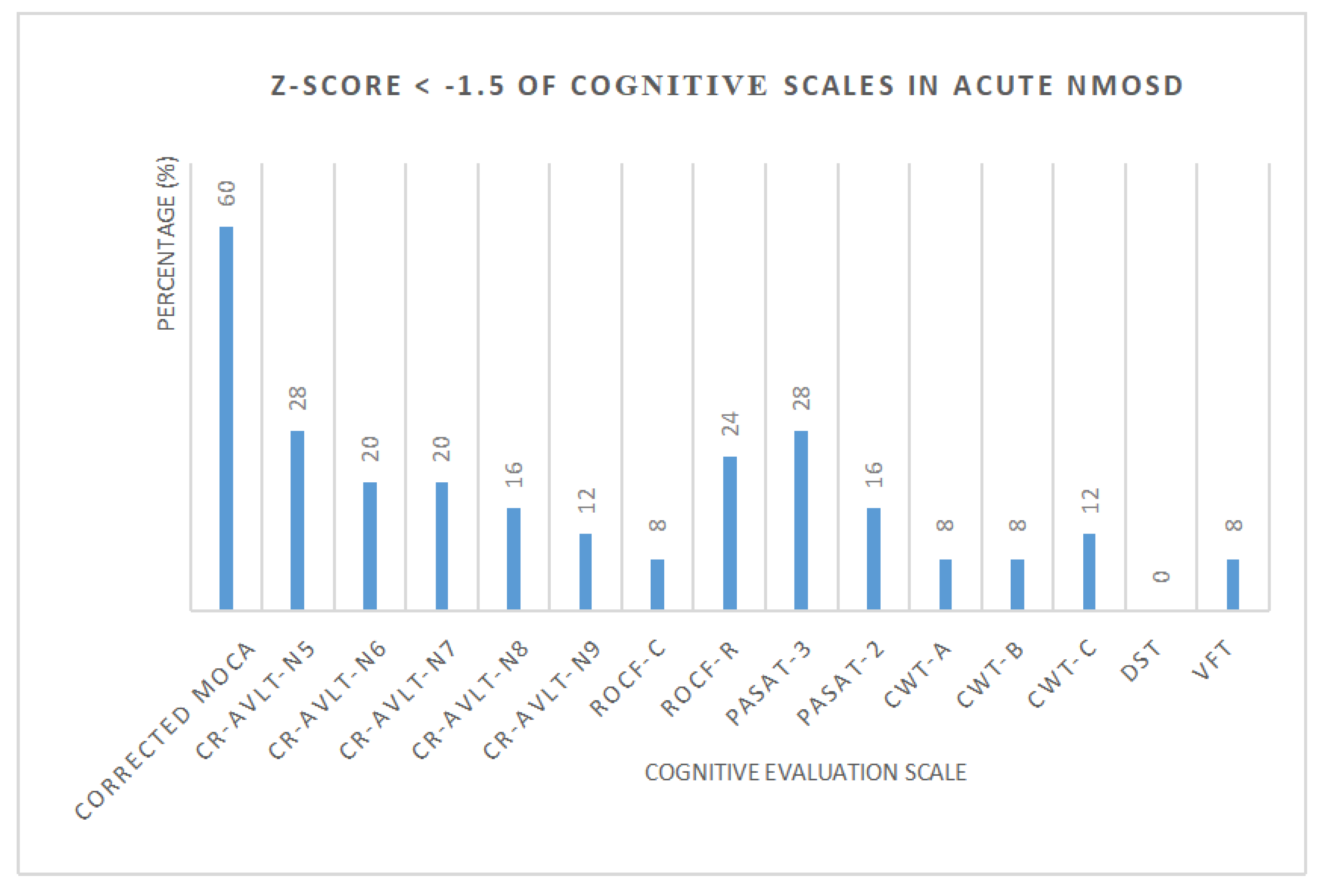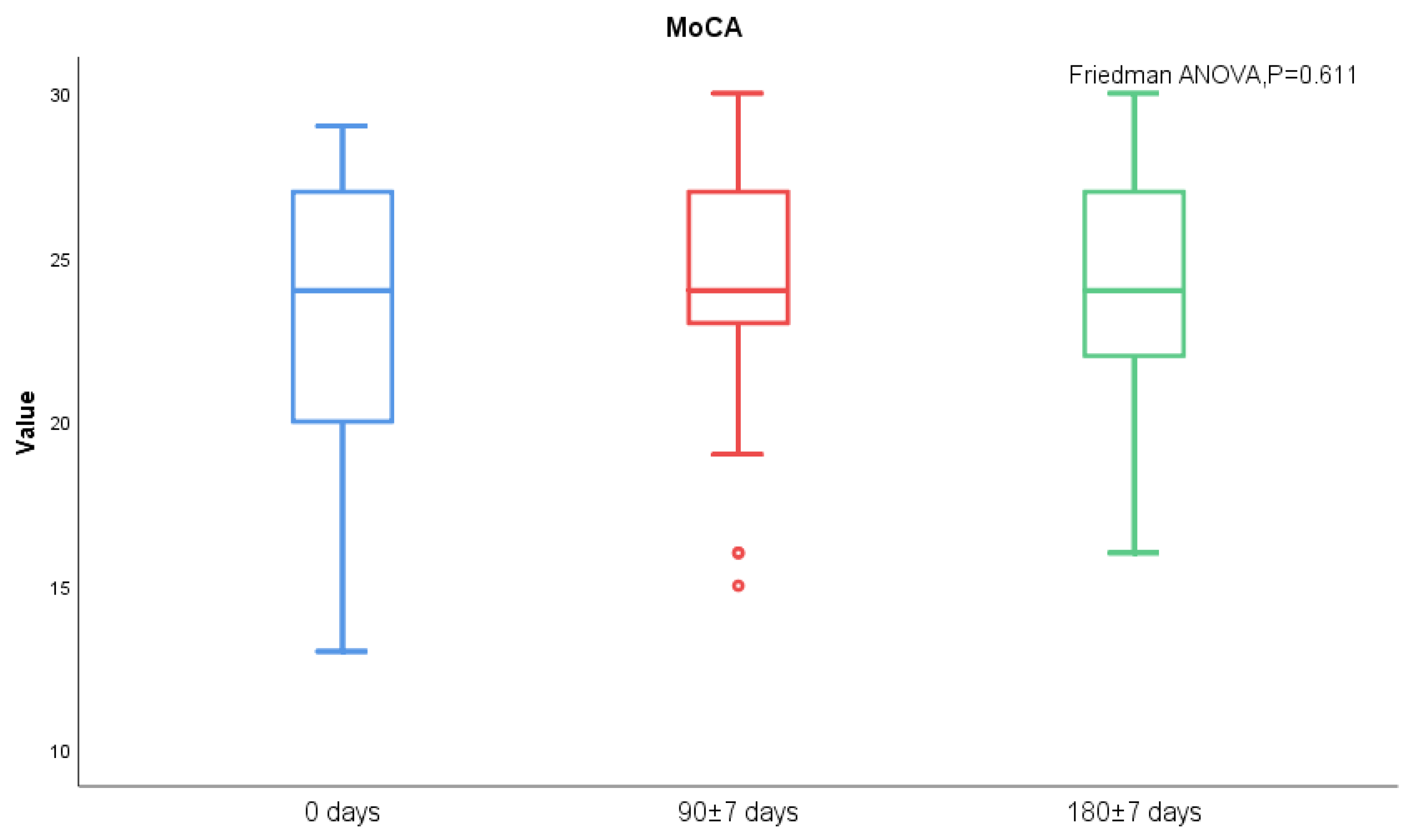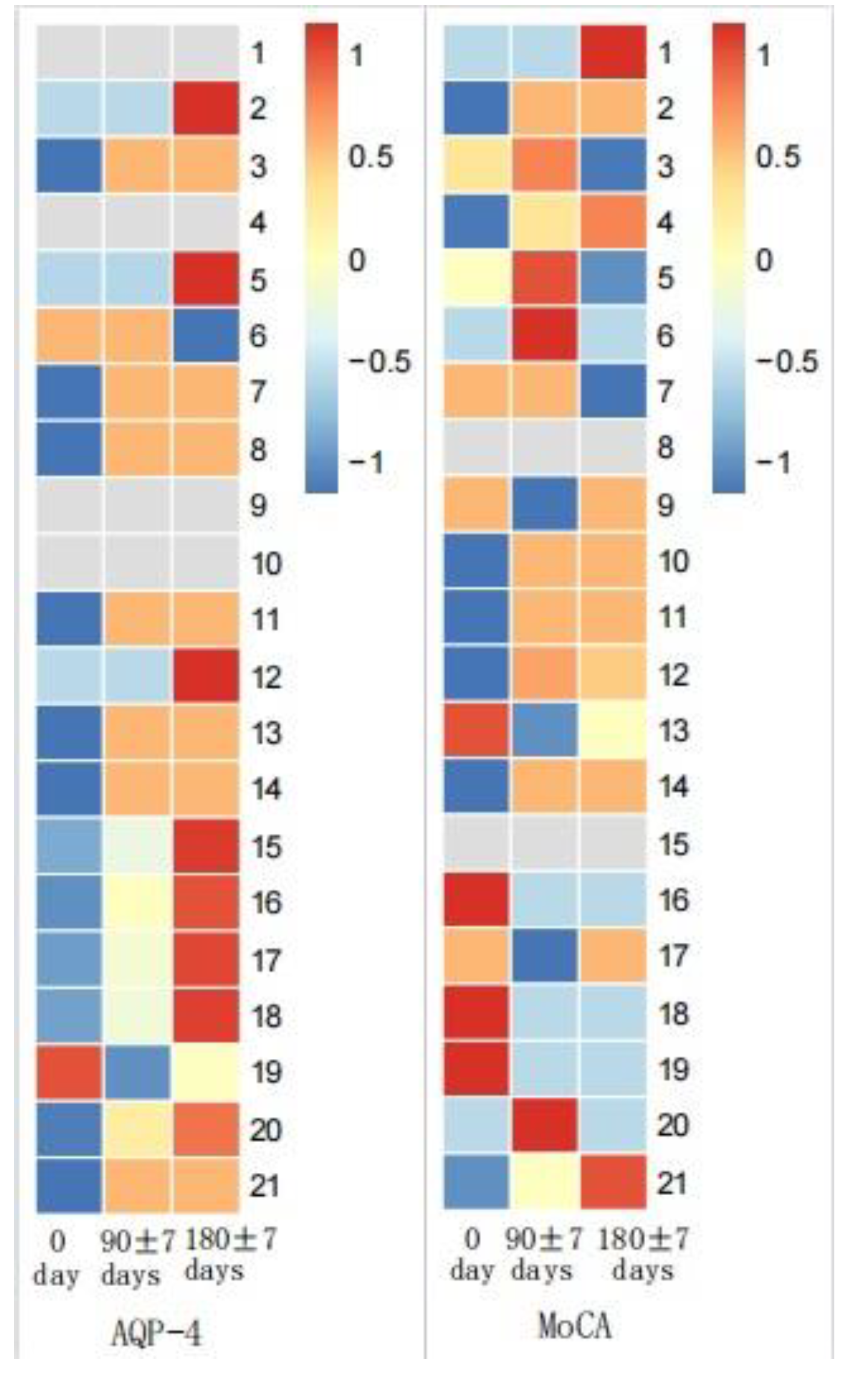The Characteristics of Cognitive Proficiency in Patients with Acute Neuromyelitis Optica Spectrum Disease and its Correlation with Serum Aquaporin-4 Antibody Titer
Abstract
1. Introduction
2. Materials and Methods
2.1. Patients
2.2. Selection Criteria of Subjects
2.3. Control Group
2.4. Clinical Assessment and Follow-Up
2.5. Assessment of Cognitive Function
2.6. Statistical Analysis
3. Results
3.1. General Information of the Research Object
3.1.1. Comparison of Cognitive Evaluation Scales between NMOSD and Control
3.1.2. Ratio of Cognitive Dysfunction in Acute NMOSD
3.1.3. Changes of MoCA and Serum AQP-4 Antibody Titers during Follow-Up
3.1.4. Correlation Analysis of Cognitive Function and other Factors in Patients with NMOSD
4. Discussion
4.1. Summary & Contributions
4.2. Benefits & Limitations
4.3. Future Work
5. Conclusions
Supplementary Materials
Author Contributions
Funding
Institutional Review Board Statement
Informed Consent Statement
Data Availability Statement
Conflicts of Interest
Abbreviations
References
- Jarius, S.; Paul, F.; Franciotta, D.; Waters, P.; Zipp, F.; Hohlfeld, R.; Vincent, A.; Wildemann, B. Mechanisms of disease: Aquaporin-4 antibodies in neuromyelitis optica. Nat. Clin. Pract. Neurol. 2008, 4, 202–214. [Google Scholar] [CrossRef] [PubMed]
- Jarius, S.; Wildemann, B. AQP4 antibodies in neuromyelitis optica: Diagnostic and pathogenetic relevance. Nat. Rev. Neurol. 2010, 6, 383–392. [Google Scholar] [CrossRef] [PubMed]
- Jarius, S.; Wildemann, B. The history of neuromyelitis optica. J. Neuroinflammation 2013, 10, 8. [Google Scholar] [CrossRef]
- Wang, Y.; Huang, C.; Guo, Q.; Chu, H. Aquaporin-4 and Cognitive Disorders. Aging Dis. 2022, 13, 61–72. [Google Scholar] [CrossRef]
- Rosu, G.C.; Catalin, B.; Balseanu, T.A.; Laurentiu, M.; Claudiu, M.; Kumar-Singh, S.; Daniel, P. Inhibition of Aquaporin 4 Decreases Amyloid Aβ40 Drainage Around Cerebral Vessels. Mol. Neurobiol. 2020, 57, 4720–4734. [Google Scholar] [CrossRef]
- Xue, X.; Zhang, W.; Zhu, J.; Chen, X.; Zhou, S.; Xu, Z.; Hu, G.; Su, C. Aquaporin-4 deficiency reduces TGF-β1 in mouse midbrains and exacerbates pathology in experimental Parkinson’s disease. J. Cell. Mol. Med. 2019, 23, 2568–2582. [Google Scholar] [CrossRef] [PubMed]
- Zeppenfeld, D.M.; Simon, M.; Haswell, J.D.; D’Abreo, D.; Murchison, C.; Quinn, J.F.; Grafe, M.R.; Woltjer, R.L.; Kaye, J.; Iliff, J.J. Association of Perivascular Localization of Aquaporin-4 With Cognition and Alzheimer Disease in Aging Brains. JAMA Neurol. 2017, 74, 91–99. [Google Scholar] [CrossRef] [PubMed]
- Lennon, V.A.; Wingerchuk, D.M.; Kryzer, T.J.; Pittock, S.J.; Lucchinetti, C.F.; Fujihara, K.; Nakashima, I.; Weinshenker, B.G. A serum autoantibody marker of neuromyelitis optica: Distinction from multiple sclerosis. Lancet 2004, 364, 2106–2112. [Google Scholar] [CrossRef]
- Lennon, V.A.; Kryzer, T.J.; Pittock, S.J.; Verkman, A.S.; Hinson, S.R. IgG marker of optic-spinal multiple sclerosis binds to the aquaporin-4 water channel. J. Exp. Med. 2005, 202, 473–477. [Google Scholar] [CrossRef]
- Blanc, F.; Noblet, V.; Jung, B.; Rousseau, F.; Renard, F.; Bourre, B.; Longato, N.; Cremel, N.; Di Bitonto, L.; Kleitz, C.; et al. White matter atrophy and cognitive dysfunctions in neuromyelitis optica. PLoS ONE 2012, 7, e33878. [Google Scholar] [CrossRef]
- Oertel, F.C.; Schließeit, J.; Brandt, A.U.; Paul, F. Cognitive Impairment in Neuromyelitis Optica Spectrum Disorders: A Review of Clinical and Neuroradiological Features. Front. Neurol. 2019, 10, 608. [Google Scholar] [CrossRef]
- He, D.; Chen, X.; Zhao, D.; Zhou, H. Cognitive function, depression, fatigue, and activities of daily living in patients with neuromyelitis optica after acute relapse. Int. J. Neurosci. 2011, 121, 677–683. [Google Scholar] [CrossRef] [PubMed]
- Vanotti, S.; Cores, E.V.; Eizaguirre, B.; Melamud, L.; Rey, R.; Villa, A. Cognitive performance of neuromyelitis optica patients: Comparison with multiple sclerosis. Arq. De Neuro-Psiquiatr. 2013, 71, 357–361. [Google Scholar] [CrossRef] [PubMed]
- Zhang, N.; Li, Y.J.; Fu, Y.; Shao, J.H.; Luo, L.L.; Yang, L.; Shi, F.D.; Liu, Y. Cognitive impairment in Chinese neuromyelitis optica. Mult. Scler. 2015, 21, 1839–1846. [Google Scholar] [CrossRef]
- Kim, S.H.; Kwak, K.; Jeong, I.H.; Hyun, J.W.; Jo, H.J.; Joung, A.; Yu, E.S.; Kim, J.H.; Lee, S.H.; Yun, S.; et al. Cognitive impairment differs between neuromyelitis optica spectrum disorder and multiple sclerosis. Mult. Scler. 2016, 22, 1850–1858. [Google Scholar] [CrossRef]
- Salama, S.; Marouf, H.; Reda, M.I.; Mansour, A.R.; EL Kholy, O.; Levy, M. Cognitive functions in Egyptian neuromyelitis optica spectrum disorder. Clin. Neurol. Neurosurg. 2020, 189, 105621. [Google Scholar] [CrossRef]
- Saji, E.; Arakawa, M.; Yanagawa, K.; Toyoshima, Y.; Yokoseki, A.; Okamoto, K.; Otsuki, M.; Akazawa, K.; Kakita, A.; Takahashi, H.; et al. Cognitive impairment and cortical degeneration in neuromyelitis optica. Ann. Neurol. 2013, 73, 65–76. [Google Scholar] [CrossRef] [PubMed]
- Wingerchuk, D.M.; Banwell, B.; Bennett, J.L.; Cabre, P.; Carroll, W.; Chitnis, T.; de Seze, J.; Fujihara, K.; Greenberg, B.; Jacob, A.; et al. International consensus diagnostic criteria for neuromyelitis optica spectrum disorders. Neurology 2015, 85, 177–189. [Google Scholar] [CrossRef] [PubMed]
- Waters, P.J.; McKeon, A.; Leite, M.I.; Rajasekharan, S.; Lennon, V.A.; Villalobos, A.; Palace, J.; Mandrekar, J.N.; Vincent, A.; Bar-Or, A.; et al. Serologic diagnosis of NMO: A multicenter comparison of aquaporin-4-IgG assays. Neurology 2012, 78, 665–669. [Google Scholar] [CrossRef]
- Davis, D.H.; Creavin, S.T.; Yip, J.L.; Noel-Storr, A.H.; Brayne, C.; Cullum, S. Montreal Cognitive Assessment for the detection of dementia. Cochrane Database Syst. Rev. 2021, 7, CD010775. [Google Scholar] [PubMed]
- Lee, T.; Yuen, K.; Chan, C. Normative data for neuropsychological measures of fluency, attention, and memory measures for Hong Kong Chinese. J. Clin. Exp. Neuropsychol. 2002, 24, 615–632. [Google Scholar] [CrossRef] [PubMed]
- Mok, E.H.; Lam, L.C.; Chiu, H.F. Category verbal fluency test performance in chinese elderly with Alzheimer’s disease. Dement. Geriatr. Cogn. Disord. 2004, 18, 120–124. [Google Scholar] [CrossRef]
- Tombaugh, T.N. A comprehensive review of the Paced Auditory Serial Addition Test (PASAT). Arch. Clin. Neuropsychol. 2006, 21, 53–76. [Google Scholar] [CrossRef]
- Silva, P.H.R.; Spedo, C.T.; Baldassarini, C.R.; Benini, C.D.; Ferreira, D.A.; Barreira, A.A.; Leoni, R.F. Brain functional and effective connectivity underlying the information processing speed assessed by the Symbol Digit Modalities Test. Neuroimage 2019, 184, 761–770. [Google Scholar] [CrossRef]
- Shin, M.S.; Park, S.Y.; Park, S.R.; Seol, S.H.; Kwon, J.S. Clinical and empirical applications of the Rey-Osterrieth Complex Figure Test. Nat. Protoc. 2006, 1, 892–899. [Google Scholar] [CrossRef]
- Periáñez, J.A.; Lubrini, G.; García-Gutiérrez, A.; Ríos-Lago, M. Construct Validity of the Stroop Color-Word Test: Influence of Speed of Visual Search, Verbal Fluency, Working Memory, Cognitive Flexibility, and Conflict Monitoring. Arch. Clin. Neuropsychol. 2021, 36, 99–111. [Google Scholar] [CrossRef]
- Valente, M.J.; Rijnhart, J.J.M.; Smyth, H.L.; Muniz, F.B.; MacKinnon, D.P. Causal Mediation Programs in R, Mplus, SAS, SPSS, and Stata. Struct. Equ. Model. 2020, 27, 975–984. [Google Scholar] [CrossRef] [PubMed]
- Liu, Y.; Fu, Y.; Schoonheim, M.M.; Zhang, N.; Fan, M.; Su, L.; Shen, Y.; Yan, Y.; Yang, L.; Wang, Q.; et al. Structural MRI substrates of cognitive impairment in neuromyelitis optica. Neurology 2015, 85, 1491–1499. [Google Scholar] [CrossRef]
- Moghadasi, A.N.; Mirmosayyeb, O.; Mohammadi, A.; Sahraian, M.A.; Ghajarzadeh, M. The prevalence of cognitive impairment in patients with neuromyelitis optica spectrum disorders (NMOSD): A systematic review and meta-analysis. Mult. Scler. Relat. Disord. 2021, 49, 102757. [Google Scholar] [CrossRef]
- Cho, E.B.; Han, C.E.; Seo, S.W.; Chin, J.; Shin, J.H.; Cho, H.J.; Seok, J.M.; Kim, S.T.; Kim, B.J.; Na, D.L.; et al. White Matter Network Disruption and Cognitive Dysfunction in Neuromyelitis Optica Spectrum Disorder. Front. Neurol. 2018, 9, 1104. [Google Scholar] [CrossRef] [PubMed]
- Benedict, R.H.; Fischer, J.S.; Archibald, C.J.; Arnett, P.A.; Beatty, W.W.; Bobholz, J.; Chelune, G.J.; Fisk, J.D.; Langdon, D.W.; Caruso, L.; et al. Minimal neuropsychological assessment of MS patients: A consensus approach. Clin. Neuropsychol. 2002, 16, 381–397. [Google Scholar] [CrossRef] [PubMed]
- Han, Y.; Liu, Y.; Zeng, C.; Luo, Q.; Xiong, H.; Zhang, X.; Li, Y. Functional Connectivity Alterations in Neuromyelitis Optica Spectrum Disorder: Correlation with Disease Duration and Cognitive Impairment. Clin. Neuroradiol. 2020, 30, 559–568. [Google Scholar] [CrossRef] [PubMed]
- Nakamura, M.; Misu, T.; Fujihara, K.; Miyazawa, I.; Nakashima, I.; Takahashi, T.; Watanabe, S.; Itoyama, Y. Occurrence of acute large and edematous callosal lesions in neuromyelitis optica. Mult. Scler. 2009, 15, 695–700. [Google Scholar] [CrossRef] [PubMed]





| Cognitive Evaluation Scales | Domain |
|---|---|
| MoCA | Overall cognitive function |
| CRAVLT | Verbal learning and memory |
| ROCF | Visual structure and visual spatial memory ability |
| PASAT-3/2 | Information processing speed, working memory and attention |
| CWT | Visual search speed, working memory, executive ability |
| DST | Attention |
| VFT | Verbal fluency |
| Cognitive Evaluation Scales (Score) | Acute NMOSD Group (n = 25) | Control Group (n = 30) | Statistical Magnitude | p Value |
|---|---|---|---|---|
| Corrected MoCA | 24.00 (20.5, 27.5) | 27.00 (26.75, 28.00) | <0.001 *** | |
| CRAVLT-N1-5 | 37.96 ± 12.60 | 41.57 ± 7.21 | t = 1.27 | 0.213 |
| CRAVLT-N6 | 3.84 ± 1.68 | 4.37 ± 1.43 | t = −1.26 | 0.213 |
| CRAVLT-N7 | 7.72 ± 3.37 | 10.07 ± 2.41 | t = −3.00 | 0.004 ** |
| CRAVLT-N8 | 7.28 ± 3.48 | 9.47 ± 2.33 | t = −2.68 | 0.011 * |
| CRAVLT-N9 | 14.00 (12.00, 15.00) | 14.00 (13.00, 15.00) | 0.072 | |
| ROCF-C | 34.00 (31.75, 36.00) | 36.00 (36.00, 36.00) | 0.005 ** | |
| ROCF-R | 11.92 ± 6.35 | 19.58 ± 4.87 | t = −5.06 | <0.001 *** |
| PASAT-3 | 35.00 ± 14.83 | 47.00 (36.00, 54.00) | 0.013 * | |
| PASAT-2 | 26.84 ± 12.59 | 34.00 (30.00, 42.50) | 0.001 ** | |
| CWT-A (second) | 28.67 ± 8.86 | 23.73 ± 4.59 | t = 2.52 | 0.017 * |
| CWT-B (second) | 38.36 ± 10.00 | 34.37 ± 8.11 | t = 1.64 | 0.107 |
| CWT-C (second) | 67.69 (56.37, 82.79) | 67.82 ± 13.23 | 0.800 | |
| DST | 12.0 (11.00, 15.00) | 14.10 ± 2.31 | 0.05 | |
| VFT | 31.60 ± 12.26 | 36.47 ± 5.24 | t = −1.85 | 0.074 |
| Cognitive Evaluation Scale | Z-Score < −1.5(The Number of People) | Percentage (%) |
|---|---|---|
| (the Z-Score of CWT > 1.5) | ||
| Corrected MoCA | 15 | 60 |
| CR-AVLT-N5 | 7 | 28 |
| CRAVLT-N6 | 5 | 20 |
| CRAVLT-N7 | 5 | 20 |
| CRAVLT-N8 | 4 | 16 |
| CRAVLT-N9 | 3 | 12 |
| ROCF-C | 2 | 8 |
| ROCF-R | 6 | 24 |
| PASAT-3 | 7 | 28 |
| PASAT-2 | 4 | 16 |
| CWT-A | 2 | 8 |
| CWT-B | 2 | 8 |
| CWT-C | 3 | 12 |
| DST | 0 | 0 |
| VFT | 2 | 8 |
| Cognitive Domain | Number of People with Disabilities | Percentage (%) |
|---|---|---|
| Verbal memory | 13 | 52 |
| Speech fluency area | 2 | 8 |
| Information processing, working memory, areas of attention | 8 | 32 |
| Visual spatial structure and visual spatial memory | 9 | 36 |
| Executive Capability Area | 5 | 20 |
| F | p | |
|---|---|---|
| AQP-4 antibody titer (the second time) | 0.127 | 0.728 |
| AQP-4 antibody titer (the third time) | 0.050 | 0.826 |
| AQP-4 antibody titer (the first time): AQP-4 antibody titer (the third time) | 4.381 | 0.057 |
| AQP-4 antibody titer (the second time): AQP-4 antibody titer (the third time) | 0.202 | 0.660 |
| Cognitive Evaluation Scale | Related Factors | R | p |
|---|---|---|---|
| MoCA | Years of Education | 0.65 | <0.001 *** |
| Intracranial lesions | −0.569 | 0.007 ** | |
| CRAVLT-N6 | Years of Education | 0.638 | 0.002 ** |
| ROCF-R | Intracranial lesions | −0.519 | 0.016 * |
| PASAT-3 | Years of Education | 0.477 | 0.029 * |
| PASAT-2 | Intracranial lesions | −0.43 | 0.047 * |
| CWT-A | Years of Education | −0.463 | 0.035 * |
| Intracranial lesions | 0.518 | 0.016 * | |
| DST | Years of Education | 0.477 | 0.029 * |
Disclaimer/Publisher’s Note: The statements, opinions and data contained in all publications are solely those of the individual author(s) and contributor(s) and not of MDPI and/or the editor(s). MDPI and/or the editor(s) disclaim responsibility for any injury to people or property resulting from any ideas, methods, instructions or products referred to in the content. |
© 2023 by the authors. Licensee MDPI, Basel, Switzerland. This article is an open access article distributed under the terms and conditions of the Creative Commons Attribution (CC BY) license (https://creativecommons.org/licenses/by/4.0/).
Share and Cite
Miao, Y.; Zhong, X.; Jia, S.; Bian, Y.; Han, J.; Qiu, F. The Characteristics of Cognitive Proficiency in Patients with Acute Neuromyelitis Optica Spectrum Disease and its Correlation with Serum Aquaporin-4 Antibody Titer. Brain Sci. 2023, 13, 90. https://doi.org/10.3390/brainsci13010090
Miao Y, Zhong X, Jia S, Bian Y, Han J, Qiu F. The Characteristics of Cognitive Proficiency in Patients with Acute Neuromyelitis Optica Spectrum Disease and its Correlation with Serum Aquaporin-4 Antibody Titer. Brain Sciences. 2023; 13(1):90. https://doi.org/10.3390/brainsci13010090
Chicago/Turabian StyleMiao, Yan, Xiaoling Zhong, Shuangshuang Jia, Yang Bian, Jinming Han, and Feng Qiu. 2023. "The Characteristics of Cognitive Proficiency in Patients with Acute Neuromyelitis Optica Spectrum Disease and its Correlation with Serum Aquaporin-4 Antibody Titer" Brain Sciences 13, no. 1: 90. https://doi.org/10.3390/brainsci13010090
APA StyleMiao, Y., Zhong, X., Jia, S., Bian, Y., Han, J., & Qiu, F. (2023). The Characteristics of Cognitive Proficiency in Patients with Acute Neuromyelitis Optica Spectrum Disease and its Correlation with Serum Aquaporin-4 Antibody Titer. Brain Sciences, 13(1), 90. https://doi.org/10.3390/brainsci13010090






